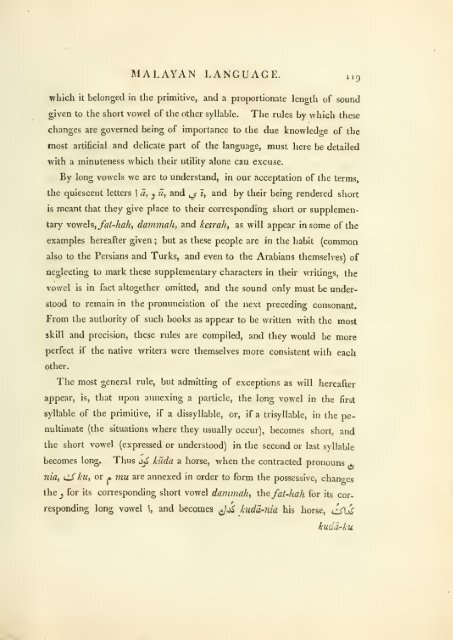A grammar of the Malayan language, with an introduction and praxis..
A grammar of the Malayan language, with an introduction and praxis..
A grammar of the Malayan language, with an introduction and praxis..
You also want an ePaper? Increase the reach of your titles
YUMPU automatically turns print PDFs into web optimized ePapers that Google loves.
MALAYAN LANGUAGE. 1 1(<br />
which it belonged in <strong>the</strong> primitive, <strong>an</strong>d a proportionate length <strong>of</strong> sound<br />
given to <strong>the</strong> short vowel <strong>of</strong> <strong>the</strong> o<strong>the</strong>r syllable. The rules by which <strong>the</strong>se<br />
ch<strong>an</strong>ges are governed being <strong>of</strong> import<strong>an</strong>ce to <strong>the</strong> due knowledge <strong>of</strong> <strong>the</strong><br />
most artificial <strong>an</strong>d dehcate part <strong>of</strong> <strong>the</strong> <strong>l<strong>an</strong>guage</strong>, must here be detailed<br />
<strong>with</strong> a minuteness which <strong>the</strong>ir utility alone c<strong>an</strong> excuse.<br />
By long vowels we are to underst<strong>an</strong>d, in our acceptation <strong>of</strong> <strong>the</strong> terms,<br />
<strong>the</strong> quiescent letters \ a, j it, <strong>an</strong>d ^ t, <strong>an</strong>d by <strong>the</strong>ir being rendered short<br />
is me<strong>an</strong>t that <strong>the</strong>y give place to <strong>the</strong>ir corresponding short or supplemen-<br />
tary \ovieh,/at-hah, dammah, <strong>an</strong>d hesrah, as will appear in some <strong>of</strong> <strong>the</strong><br />
examples hereafter given ; but as <strong>the</strong>se people are in <strong>the</strong> habit (common<br />
also to <strong>the</strong> Persi<strong>an</strong>s <strong>an</strong>d Turks, <strong>an</strong>d even to <strong>the</strong> Arabi<strong>an</strong>s <strong>the</strong>mselves) <strong>of</strong><br />
neglecting to mark <strong>the</strong>se supplementary characters in <strong>the</strong>ir writings, <strong>the</strong><br />
vowel is in fact altoge<strong>the</strong>r omitted, <strong>an</strong>d <strong>the</strong> sound only must be under-<br />
stood to remain in <strong>the</strong> pronunciation <strong>of</strong> <strong>the</strong> next preceding conson<strong>an</strong>t.<br />
From <strong>the</strong> authority <strong>of</strong> such books as appear to be written <strong>with</strong> <strong>the</strong> most<br />
skill <strong>an</strong>d precision, <strong>the</strong>se rules are compiled, <strong>an</strong>d <strong>the</strong>y would be more<br />
perfect if <strong>the</strong> native writers were <strong>the</strong>mselves more consistent <strong>with</strong> each<br />
o<strong>the</strong>r.<br />
The most general rule, but admitting <strong>of</strong> exceptions as will hereafter<br />
appear, is, that upon <strong>an</strong>nexing a particle, <strong>the</strong> long vowel in <strong>the</strong> first<br />
syllable <strong>of</strong> <strong>the</strong> primitive, if a dissyllable, or, if a trisyllable, in <strong>the</strong> pe-<br />
nultimate (<strong>the</strong> situations where <strong>the</strong>y usually occur), becomes short, <strong>an</strong>d<br />
<strong>the</strong> short vowel (expressed or understood) in <strong>the</strong> second or last syllable<br />
becomes long. Thus ^^ kuda a horse, when <strong>the</strong> contracted pronouns ^<br />
nia, cSku, or * 7nu are <strong>an</strong>nexed in order to form <strong>the</strong> possessive, ch<strong>an</strong>oes<br />
<strong>the</strong> J for its corresponding short vowel dammahy <strong>the</strong> fat-hah for its cor-<br />
responding long vowel I, <strong>an</strong>d becomes ^\^ kuda-liia his horse, i^\^<br />
kuda-ku

















